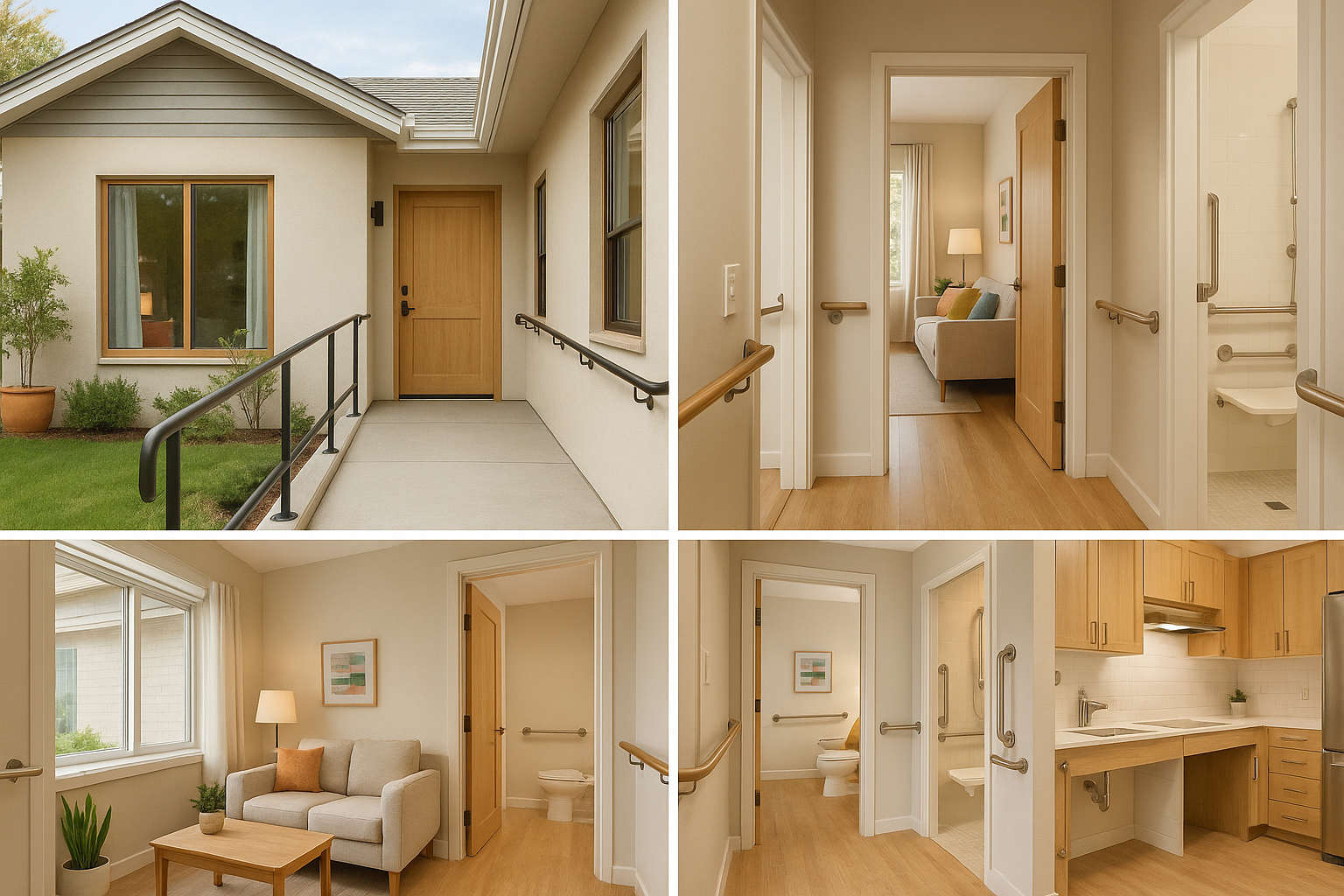🏡 But here’s the truth: enhancing accessibility can sometimes feel daunting, especially when you’re working with a tight budget. Yet, it doesn’t have to be. This article aims to guide you through the process, offering practical, budget-friendly accessibility solutions that don’t break the bank.💰
The world is gradually waking up to the importance of accessibility, recognizing that an accessible environment is not a privilege, but a basic right.😌 Still, many people are deterred by the supposed high costs associated with improving accessibility. They hesitate, fearing that modifications will put a dent in their wallets. This article debunks such misconceptions and provides insights into cost-effective ways to enhance accessibility, whether you’re an individual homeowner, a business owner, or a public administrator.
Before we dive deep into our guide, it’s important to understand what we mean when we say ‘accessibility’. In essence, it’s about creating environments that cater to everyone’s needs, regardless of physical abilities or age. It’s about reducing barriers and fostering inclusion.💪
Now, let’s imagine a scenario: a visitor comes to your office. They use a wheelchair, but alas, there’s a flight of stairs leading to the main entrance. The visitor can’t access your office because it’s not wheelchair-friendly. This scenario is just one example of many where the lack of accessibility creates barriers. But how do you make your space accessible without spending a fortune? That’s what we’ll discuss in this article.👍
Firstly, we’ll shed light on the common misconceptions associated with accessibility modifications. The idea that improving accessibility is expensive is largely a myth, and we aim to bust this wide open.💡 Next, we’ll delve into the principle of universal design – a concept that integrates accessibility into the design phase rather than as an afterthought. Integrating this principle can save you both time and money in the long run. We’ll walk you through some real-world examples of universal design, showing you how it’s both feasible and affordable.
Then, we’ll introduce some practical, budget-friendly modifications that can significantly improve accessibility in various settings. These will range from simple DIY projects 🛠️ like installing grab bars and ramps to more sophisticated solutions like assistive technology. We’ll illustrate that you don’t need to overhaul your entire space or drain your savings to enhance accessibility.
Finally, we’ll provide a comprehensive list of resources where you can find more information and help, as well as places where you can purchase affordable accessibility tools and equipment.📚 We’ll also offer guidance on potential funding options and grants that may be available to offset the cost of accessibility improvements.
Through this article, we hope to demystify the cost of accessibility, proving that it’s possible to create inclusive, accessible spaces even on a budget. So, whether you’re a homeowner hoping to make your space more comfortable for aging relatives, a business owner wanting to cater to a wider range of customers, or a public administrator looking to improve accessibility in community facilities, this guide is for you.
Ready to embark on the journey of making your spaces more accessible without emptying your bank account? Let’s dive right in! 🏊♂️
Understanding Accessibility: Creating Inclusive Spaces on a Budget
When we think about accessible spaces, we often imagine high-tech solutions that only large businesses or wealthy individuals can afford. However, accessibility doesn’t have to come at a steep price. In fact, there are plenty of budget-friendly ways to make any space more accessible, whether you’re a small business owner, a property manager, or just someone who wants to make their home more welcoming to all. With a little creativity and strategic planning, you can make significant improvements without breaking the bank.
In this article, we’ll explore some cost-effective strategies for improving accessibility in various spaces. We’ll look at everything from minor modifications to more substantial changes, offering a range of options to fit different budgets. By the end of this read, you’ll have a better understanding of how you can make your space more accessible without making a massive dent in your wallet.
Before we dive in, let’s watch a video to get a clear picture of what accessibility really means and why it’s so essential. The video “The Importance of Accessibility | Web Accessibility | Google Developers” from Google Developers will provide a comprehensive overview.
Easy and Affordable Accessibility Fixes
There are many simple and affordable ways to improve the accessibility of a space. These can range from straightforward fixes, like adding handrails to staircases, to more involved projects, like installing ramps or creating wider doorways. The key is to focus on the most critical areas first, such as entrances and restrooms, and then gradually work your way through the rest of the space.
Let’s look at a few easy and affordable accessibility fixes. These are perfect for those who are on a tight budget but still want to make a significant difference.
Add Signage
Adding clear, high-contrast signage is one of the simplest and most effective ways to improve accessibility. Signage can be used to indicate accessible entrances, restrooms, and parking spaces, making it easier for everyone to navigate the space.
Install Handrails
Handrails can make a huge difference in the accessibility of a space. They can be installed alongside staircases, ramps, and in restrooms, providing essential support for those who need it.
Use Non-Slip Mats
Slips and falls can be a significant barrier to accessibility. To mitigate this risk, consider investing in non-slip mats for areas prone to spills or slick surfaces, such as kitchens and bathrooms.
More Involved Accessibility Solutions That Won’t Break the Bank
While the fixes mentioned above can make a significant difference, you may want to consider some more substantial changes if your budget allows. These modifications will require more time and resources, but they can also have a more profound impact on the accessibility of your space.
Installing Ramps
Stairs can pose a major challenge for people with mobility issues. Installing ramps is a more substantial modification that can greatly improve accessibility. Portable ramps are a less expensive option that can be moved as needed, providing a flexible solution.
Creating Wider Doorways
Doorways can be a major barrier for individuals using wheelchairs or walkers. Widening doorways can be a more significant project, but it’s an effective way to improve accessibility in your space.
Lowering Counters and Sinks
For individuals who use wheelchairs, high counters and sinks can be difficult to use. Lowering these can make a significant difference in the usability of a space.
Comparing Accessibility Solutions
When deciding on the best accessibility solutions for your space, it’s essential to consider both the cost and the potential impact. To help you make an informed decision, we’ve created a comparative table of the solutions discussed in this article.
| Solution | Cost | Impact on Accessibility |
|---|---|---|
| Adding signage | Low | High |
| Installing handrails | Medium | High |
| Using non-slip mats | Low | Medium |
| Installing ramps | High | Very High |
| Creating wider doorways | High | Very High |
| Lowering counters and sinks | High | Very High |
Refer to this table as you consider your options. Remember, even small changes can make a big difference in improving accessibility, and every step you take towards creating a more inclusive space is a step in the right direction.

Conclusion
In conclusion, the intricacies of software engineering and information technology are vast and multifaceted. It has been a pleasure taking you on this journey, exploring the depths of these disciplines, and I hope that you’ve found it as enlightening and engaging as I have. 🧩👩💻
We started our journey with an in-depth look at the fundamental principles of software engineering. These principles provide the bedrock on which every software application is built, and understanding them is the first step towards creating robust, efficient, and user-friendly software. We then delved into the fascinating world of IT infrastructure, learning about the key components that make up this complex landscape and how they all work together to support business operations. 💻🌐
From there, we explored the critical role of data management in both software engineering and IT. We discussed the importance of data integrity, security, and privacy, and how these concepts are vital for the smooth operation of any modern organization. In this digital age, data is the lifeblood of business, and managing it effectively is more important than ever. 🗃️🔒
We also took a deep dive into the cutting-edge technologies that are transforming the field, including artificial intelligence, machine learning, and the Internet of Things. These exciting advancements are revolutionizing the way we interact with technology, opening up endless possibilities for innovation and progress. 🤖🌍
Finally, we discussed the future of software engineering and IT. With the constant evolution of technology, the only thing we can be certain of is that the landscape will continue to change and evolve, presenting new challenges and opportunities. As professionals in these fields, it is our responsibility to stay ahead of the curve and keep ourselves updated with the latest trends and developments. 🚀🔮
I hope that this article has provided you with valuable insights into the world of software engineering and IT. The complexities of these disciplines can seem daunting, but with a solid foundation and a thirst for knowledge, you can navigate this landscape with confidence and skill.
I encourage you to continue exploring, learning, and applying the knowledge you’ve gained. Share this article with your colleagues and friends who may find it useful, and don’t hesitate to leave your comments and thoughts below. I always enjoy hearing from my readers, and your feedback is invaluable in shaping future content. 📝📚
Thank you for reading, and until next time, keep pushing the boundaries of what’s possible in the world of software engineering and IT. 🙌🚀
For further reading, you may find these sources helpful:
– IEEE Xplore Digital Library
– Computer Society Digital Library
– ScienceDirect
Remember to always check the reliability of your sources and stay informed with up-to-date, accurate information. Knowledge is power, and in this rapidly evolving field, it is your most valuable asset. 🎓💼
And remember, as Albert Einstein once said, “The important thing is not to stop questioning. Curiosity has its own reason for existing.” Stay curious, stay informed, and stay ahead. 🌠🏁
All the best,
Rodrigo Almeida 🖊️



